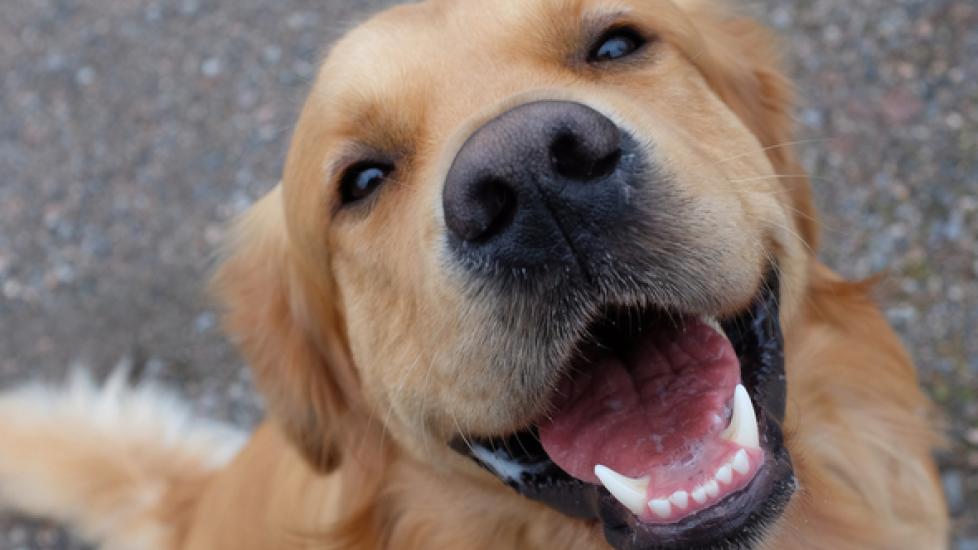Do Dogs Smile? If So, Why?
If you have a dog, you’ve probably seen that endearing look—the relaxed face, soft eyes, and wide grin. It’s hard to believe that your dog isn’t smiling at you, but do dogs smile like we do? If so, why?
Can Dogs Really Smile?
Most behaviorists don’t really consider a dog “smiling” to be a true grin in the way we think about a human smile.
Many canine expressions can be seen as a “smile,” including wide-mouth panting, relaxing with their tongues out, and submissive grins. Even aggressive baring of the teeth can be mistaken by some as a friendly greeting.
However, most of the time when dogs smile, they are indeed happy, so it’s easy to relate that expression to human smiles.
Most scientists think the canine smile stems from a combination of evolution and the fact that dogs are masters of analyzing human behavior. They know exactly how to make us happy. Since most humans react when they see a dog smile—either by smiling back, making approving noises, or providing treats—the dog is rewarded for this behavior and does it more often.
Genetically, this behavior may come from neoteny, which means when animals become domesticated, they retain some behaviors from puppyhood in adulthood. This includes emotional greetings, jumping, tail-wagging, licking, and yes—the adorable canine smile.
Do Dogs Smile at Other Dogs?
Sometimes, we smile at other people as a social ritual just to express friendliness. Domesticated dogs will do something similar, but they go beyond facial expressions. Dogs use their entire body posture to communicate a message to other dogs, such as “I’m friendly and just want to play,” or, “This is my owner; please keep your distance,” or, “Take one step closer and I’ll let you have it!”
Just as we can tell when people are giving us a “fake” smile, dogs can tell what messages are being conveyed by reading the body language of another dog.
Do Dogs Mimic Our Smiles?
Dogs don’t really mimic our smiles, but they may be triggered to smile more when they see us smiling. Most dogs really like the happy reaction they get when they please humans and quickly learn how to trigger that happy emotion. For some dogs, that includes smiling.
The phenomenon that causes a dog to smile when we smile at them is similar to “laughter contagion.” Just as one person laughing heartily can trigger another person to start laughing, a happy person that smiles can trigger a happy dog to smile back. Vice versa, a grinning dog can trigger an oxytocin release in humans and a happy response.
It is important to remember, however, that every dog is an individual and responds to varying situations differently; what may cause the smile reaction in one animal may not trigger it in another.
Do Dogs Like When People Smile?
Most dogs love pleasing their owners and know that smiling is human body language for happiness. The majority of dogs are very good at interpreting human body language. They can tell when we are pleased, sad, or disappointed.
They also know that our happiness often means extra attention, treats, and fun time for them. Not only do they like making us happy, but they like how we treat them when we are happy!
Dogs tend to read the body language that goes along with a human’s smile. They often instinctively understand that smiling and showing teeth is not a human form of aggression (as it might be with other dogs), even if the person is a stranger.
Do Dogs Smile With Their Teeth When They Feel Guilty?
You’ve probably seen videos of a dog that’s gotten into something, and when the owner finds out, the dog responds with a “grin.” Is this a sign that the dog actually feels guilty for what they did? Probably not.
Once again, a dog’s body language is key. Not only are they showing their teeth with their lips drawn back, but they are also usually lowering their heads and squinting their eyes. Often, their ears are flattened, their tail is wagging, and their body posture looks submissive.
Grins in response to naughty behavior are not actually signs of aggression nor guilt, but rather submission. Generally, the dog is aware that you are not happy about something that they did, and they are responding to your emotions. Dogs use submissive grins to defuse aggression and reassure you that they don’t pose a threat.
How Can You Tell If Your Dog Is Happy If They Aren't Smiling?
Not all dogs will smile, even when they’re happy. So how do you know if your dog is happy?
Look at your dog’s body language. A happy dog will have a relaxed body posture and often, a wagging tail. Their face will look soft and calm, and if they’re playing or running, you’ll often see a wide, panting smile.
Most dogs aren’t particularly subtle when they’re happy, and they will reflect your happiness, as well.
Featured Image: iStock.com/SariJuurinen
Help us make PetMD better
Was this article helpful?
